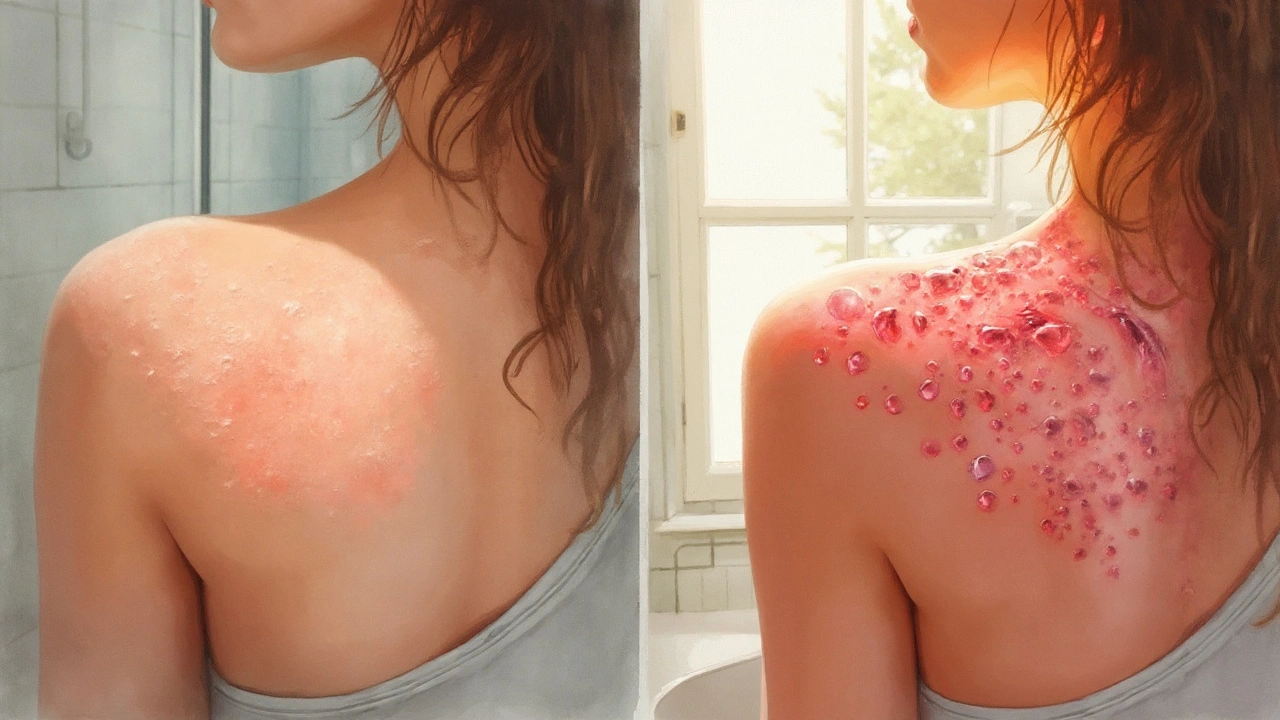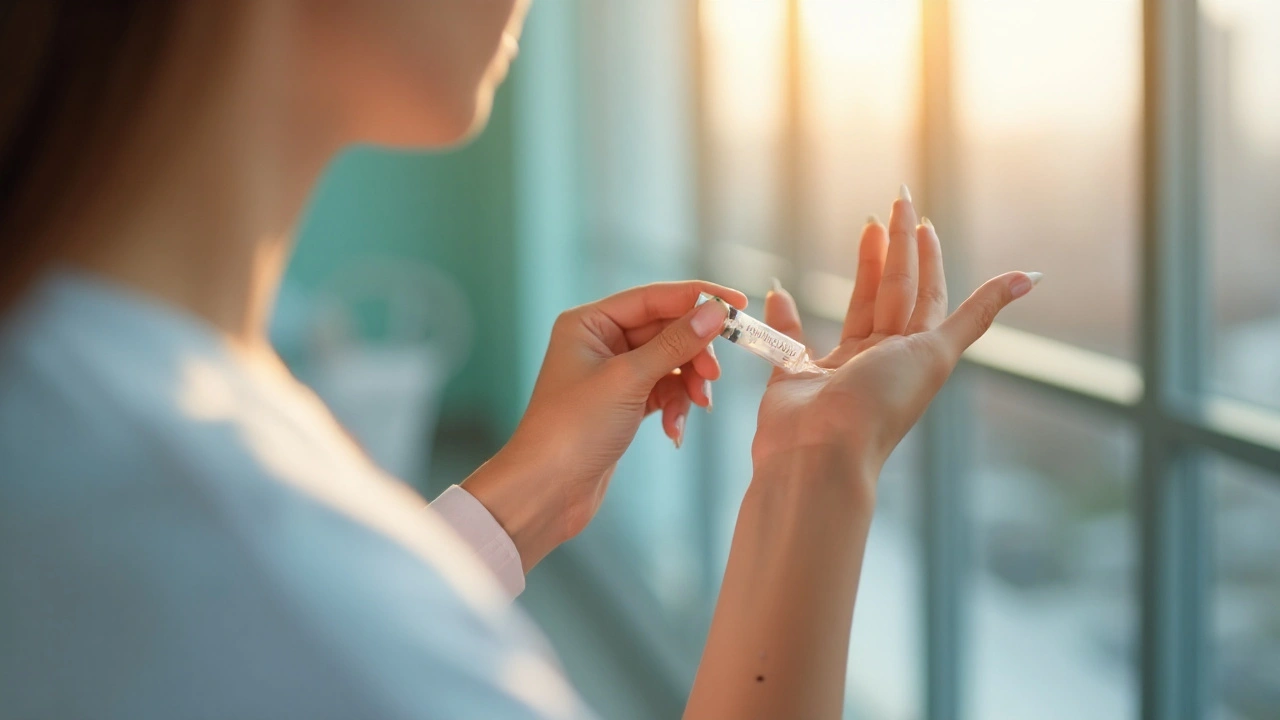Platelet‑rich plasma therapy is a minimally invasive procedure that uses a patient’s own blood components to stimulate tissue repair, characterized by a high concentration of platelets and associated growth factors. By concentrating these elements and injecting them into scar tissue, PRP jump‑starts the body’s natural healing cascade, leading to smoother, softer scars.
TL;DR
- PRP delivers a burst of growth factors that accelerate collagen remodeling.
- It works naturally with the body’s own healing phases, cutting scar thickness by up to 40% in clinical trials.
- Side effects are rare because the injection is autologous (your own blood).
- Typical protocol: 3‑4 sessions spaced 4‑6 weeks apart.
- Compared to laser or silicone gel, PRP offers longer-lasting results with minimal downtime.
How PRP Works: From Blood Draw to Healing Boost
The process begins with a standard venipuncture. Blood is spun in a centrifuge, separating it into three layers: red cells, platelet‑poor plasma, and the coveted platelets (tiny cell fragments that store and release growth factors). The middle “buffy coat” rich in platelets is extracted, yielding platelet‑rich plasma ready for injection.
Once injected into the scar, the platelets degranulate, releasing a cocktail of growth factors (proteins like PDGF, TGF‑β, VEGF, and EGF that direct cell migration, proliferation, and angiogenesis). These molecules act as messengers, telling nearby fibroblasts to ramp up collagen synthesis and reorganize the extracellular matrix.
Key Biological Benefits for Scar Tissue
Scar formation follows three overlapping phases: inflammation, proliferation, and remodeling. PRP intervenes at each stage:
- Inflammation: Growth factors recruit macrophages that clear debris, reducing chronic inflammation that often hardens scars.
- Proliferation: dermal fibroblasts (cells responsible for producing collagen and elastin) receive a surge of signals, leading to increased typeIII collagen, which is more pliable than the typeI collagen dominant in mature scars.
- Remodeling: The accelerated turnover replaces disorganized fibrils with a more ordered collagen (structural protein that gives skin its strength and elasticity) network, softening texture and flattening elevation.
Because PRP is autologous, the immune system recognises it as “self,” so there’s virtually no risk of rejection or allergic reaction.
What the Research Says
Several randomized controlled trials have quantified PRP’s impact on various scar types. A 2022 multicenter study involving 124 patients with post‑surgical hypertrophic scars reported a mean reduction of 38% in scar thickness after four PRP sessions, measured by high‑frequency ultrasound. Another trial on acne‑related atrophic scars showed a 2‑point improvement on the validated Global Acne Scarring Classification, compared to a 0.5‑point change with placebo.
Clinical studies (peer‑reviewed research evaluating safety and efficacy of PRP for scar management) consistently note low adverse‑event rates (<2% mild bruising) and high patient satisfaction (>85% would repeat the treatment).

Comparison with Other Scar‑Improvement Options
| Treatment | Mechanism | Typical Sessions | Downtime | Average Cost (US$) | Evidence‑Based Efficacy |
|---|---|---|---|---|---|
| Platelet‑rich plasma | Autologous growth‑factor injection | 3‑4 | 1‑2 days mild redness | 1,200-1,800 | 30‑40% scar reduction (RCTs) |
| Laser resurfacing | Controlled dermal ablation | 1‑3 | 1‑2 weeks | 1,500-3,000 | 20‑30% reduction (meta‑analysis) |
| Silicone gel sheeting | Hydration & occlusion | Continuous wear 8‑12weeks | None | 200-400 | 10‑15% flattening (clinical reports) |
| Microneedling | Mechanical collagen induction | 4‑6 | 2‑3 days erythema | 800-1,200 | 15‑25% improvement (controlled trials) |
PRP stands out for its biologic approach, minimal downtime, and lasting remodeling effects. It pairs well with other modalities-many clinicians follow PRP with laser resurfacing to refine final texture.
Practical Considerations Before You Book
- Autologous injection: Your own blood is used, eliminating cross‑contamination concerns.
- Side effects: Temporary bruising or mild swelling; rare infection if aseptic technique lapses.
- Cost vs. benefit: While upfront price is higher than silicone gels, the reduced number of sessions and longer durability often offset long‑term expenses.
- Regulatory status: In the United States, PRP is classified as a medical device ( FDA‑regulated procedure when used for therapeutic purposes), and most dermatology clinics operate under a physician‑supervised protocol.
- Ideal candidates: People with mature (≥6 months old) hypertrophic or atrophic scars, good general health, and realistic expectations.
Related Concepts and Future Directions
Beyond scar healing, PRP is gaining traction in other aesthetic and regenerative fields. For instance, hair restoration clinics use PRP to stimulate follicular growth, while sports medicine leverages it for tendon and ligament repair. Ongoing research explores combining PRP with stem‑cell concentrates to amplify regenerative potential.
If you’re curious about the next steps, consider reading about microneedling with PRP (the "vampire facial"), or the emerging role of nanofat grafting in deep scar revision. Each builds on the same principle: delivering the body’s own healing ingredients where they’re needed most.
Frequently Asked Questions
How many PRP sessions are needed for noticeable scar improvement?
Most protocols recommend 3‑4 sessions spaced 4‑6 weeks apart. Patients typically see visible softening after the second session, with optimal results emerging by the fourth.
Is PRP safe for all skin types?
Because PRP uses your own blood, it’s safe across Fitzpatrick skin types I-VI. The main contraindications are active infections, uncontrolled diabetes, or anticoagulant therapy that impairs clotting.
Can PRP be combined with other scar treatments?
Yes. Many clinicians use PRP before or after laser resurfacing, microneedling, or silicone gel applications to boost collagen turnover and accelerate healing.
What is the downtime after a PRP injection?
Downtime is minimal-usually 1‑2 days of mild redness or swelling that resolves on its own. No special post‑procedure care beyond keeping the area clean is needed.
How does PRP compare cost‑wise to laser resurfacing?
A full PRP course (3‑4 sessions) typically costs $1,200-$1,800, while a single laser resurfacing session can range $1,500-$3,000. When multiple laser passes are required, PRP may become the more economical option in the long run.



PRP is such a game-changer for scars-no more waiting months for laser burns to heal. My cousin did this after her C-section and said her scar went from raised and angry to almost invisible. No drama, no downtime, just your body doing what it’s already wired to do. Honestly? It’s the future.
And honestly? Why are we still paying $3k for lasers when we’ve got this?
Let’s be real-PRP isn’t magic, it’s biology. You’re basically giving your skin a high-dose vitamin shot made of its own blood. The growth factors? PDGF, TGF-beta, VEGF-they’re not some sci-fi cocktail, they’re the same signals your body uses to patch up a paper cut. It’s just… optimized.
And yes, it’s pricier than silicone gel, but when you factor in how many months you’re slapping that gel on and how little it actually does? PRP’s ROI is way better. Plus, you’re not just masking the scar-you’re remodeling it.
Interesting how they call this 'autologous' like it's some revolutionary thing. Ever heard of blood transfusions? Or stem cell banking? This is just a fancy centrifuge trick. And don't get me started on the FDA classification-'medical device'? That’s like calling a hammer a 'precision impact tool'.
Also, where's the long-term data? 2022 study? That’s not evidence, that’s a pilot. And why no control group using saline? Just saying.
Also, who funds these studies? Hint: not your grandma's clinic.
👀
They say 'your own blood' like it’s a patriotic act. Meanwhile, the pharmaceutical industry is quietly patenting the centrifuge protocols and charging $1,800 per session. This isn’t healing-it’s biotech capitalism. You’re paying to use your own body’s resources while some CEO in a lab coat sips kombucha and counts his profits.
And don’t tell me about 'minimal downtime.' What about the psychological toll of being told you need four sessions? You’re not healing-you’re being monetized.
Think about this: scars are stories your body tells about trauma. PRP doesn’t erase them-it helps your body rewrite the narrative with less jagged grammar. That’s not medicine. That’s poetry with a syringe.
And yet we reduce it to cost-per-session charts and ultrasound measurements. We’ve forgotten that skin remembers. It holds grief, rage, survival. PRP doesn’t just stimulate fibroblasts-it gives the tissue permission to heal differently. That’s spiritual. That’s sacred. And no table comparing it to silicone gel will ever capture that.
Okay but have you ever had a PRP session? I mean, really? The needle goes in, you feel that weird pressure like your skin is being gently sucked into a vacuum, and then-nothing. No pain, no buzz, just silence. And then you sit there for 20 minutes wondering if you just wasted $450.
And then you look in the mirror a week later and… it’s softer? Like, really? How? Is it placebo? Or is your body just tired of being a mess and finally said ‘fine, I’ll fix it’?
I need answers. I need to know if this is science or soul work.
PRP is the OG glow-up. No filters, no lasers, no burning your face off. Just your blood saying 'hey, let’s do this right this time.'
I did three sessions after my burn scar and now my arm looks like it never happened. My mom cried. I didn’t. I just smiled and ordered another coffee.
Also-stop comparing it to silicone gel. That’s like comparing a Ferrari to a bicycle with training wheels. Same destination, different energy.
Also also-do it before you’re 35. Your future self will thank you.
I’ve been doing PRP for my acne scars for a year now. Four sessions. No drama. No downtime. Just a little redness that fades by dinner.
My dermatologist said I’m a great candidate because my scars were mature and I didn’t smoke. That’s the key-timing matters. Don’t rush it.
And if you’re worried about cost? Think of it as an investment in not flinching when you see your reflection. That’s worth more than any cream.
Okay but why is this even a thing? I mean, you’re literally injecting your own blood into your face. Isn’t that just… gross? Like, I get the science but like-why not just drink your blood? Or rub it on? Why inject it? Why not just eat the platelets? Are we just pretending this is science because it sounds cool?
Also, I saw a TikTok where someone did this at a spa with a guy in a lab coat and a playlist of lo-fi beats. That’s not medicine. That’s a vibe.
What if the real benefit isn’t the collagen remodeling? What if it’s the ritual? The quiet hour spent in a sterile room, your blood spinning in that centrifuge like a cosmic hourglass, your body whispering: I am still here. I am still whole.
Maybe the growth factors are just the vehicle. The real medicine is the pause. The permission. The belief that healing isn’t something you buy-it’s something you allow.
Just thinking out loud.
PRP works. I tried it. My scar faded. Done.
Also, laser is overrated. Silicone gel is boring. This is the sweet spot.
Did you know the centrifuge used in PRP is the same tech that was patented by a company that also made bioweapon delivery systems? Coincidence? I think not.
And the 'autologous' claim? That’s just marketing. The serum is often stored in plastic tubes that leach endocrine disruptors. You think you’re healing yourself-but you’re just absorbing microplastics from your own blood.
Also, why do all the clinics use the same brand of tubes? Who owns them? Who controls the supply chain?
Look up the patent filings. I dare you.
PRP is like the Japanese tea ceremony but for your skin. Slow. Intentional. Sacred.
Also, I got mine in Bali with a guy who chanted mantras while spinning the centrifuge. It wasn’t just science-it was *spiritual engineering*. My scar didn’t just fade… it *sighed*. 🌸
And yes, I cried. And no, I don’t regret it. Not one bit.
Also, I’m now vegan because of it. The universe spoke.
I just wanted to say thank you for sharing this. I’ve been scared to try anything for my scar since my accident. This made me feel like maybe it’s okay to hope again.
Let’s be clear-PRP is not a breakthrough, it’s a repackaging of 1980s platelet research with modern branding. The clinical data is underpowered, the sample sizes tiny, and the cost-to-benefit ratio is skewed by clinic marketing budgets. You think you’re getting regenerative medicine? You’re getting a $1,500 placebo with a centrifuge.
And don’t get me started on the 'minimal downtime' claim. Redness? Swelling? That’s inflammation. You’re not healing-you’re triggering a controlled flare-up and calling it therapy.
Real healing is patience. Not injections.
While I acknowledge the biological plausibility of platelet-rich plasma, I must express my concern regarding the commodification of autologous therapies. The elevation of this procedure to a premium aesthetic service, divorced from its origins in orthopedic and trauma care, reflects a troubling trend in modern medicine: the prioritization of profit over principle.
Furthermore, the assertion that PRP offers 'longer-lasting results' lacks longitudinal validation. Until peer-reviewed studies with five-year follow-ups are published, such claims remain speculative. One must exercise caution before embracing unproven modalities as standard of care.
Bro I get it you're salty because you didn't get your PRP covered by insurance but come on
My scar is flat now and I didn't have to wear a face mask for two weeks like some lab rat
Also I did it in a clinic that didn't play spa music so I'm not a cult member
Stop being mad at progress